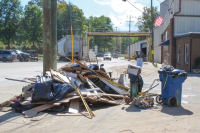A page from the past: Smokies’ artifacts tender rare glimpse into life before the park
The Great Smoky Mountains National Park is home to one of the most intact and comprehensive collections of early Americana, lining row after row, room upon room, of metal shelves, drawers and floor space in a sprawling, albeit hidden, storehouse.
A gander through the vast collection brings people of the past back to life. A knife worn on the belt of a farmer from sunrise to sunset, a dipper tipped to the mouth of thirsty children during a break from hoeing, quilt pieces painstakingly stitched by lamplight on winter nights, glass salt cellars proudly set at each place for Sunday dinner.
“Every usable item tells a story about how people lived, how they worked, how hard life could have been for them, as well as the ingenuity that went into building it. Sometimes I think, ‘How did anyone ever think to build something like this?’” said Dianne Flaugh, the park’s caretaker of the artifact collection.
Much of the collection is attributed to the work of two early park rangers who were savvy enough to scoop up items from the families living in the park at the time of its creation. The men, Hiram Wilburn and Charles Grossman, traveled around the countryside visiting the mountaineers being evacuated from their homes and farms to make way for the park.
They had one major advantage. The families simply couldn’t take everything with them. The park provided no moving assistance, posing a serious hardship. For families with several small children or elderly in their ranks, multiple wagon trips over the mountains to cart out possessions was simply not possible.
“It was a matter of people packing and deciding ‘Do I need this much stuff?’ So large things like looms or broken kettles were left behind,” said Flaugh.
Related Items
The park’s collection continued to grow over the years.
“Even today people come to us and say ‘This was owned by grandmother. She grew up in the park. We want you to have it,’” Flaugh said.
But Grossman and Wilburn soon encountered a problem that would continue to plague the park for decades: where to put it all. The early historians stashed their treasure in any nook and cranny they could find. The artifacts continued to be shunted about every couple of decades, squirreled away in the attics and basements of park buildings, including a stint in the loft of Mingus Mill.
Through the collection’s many twists and turns, its varied caretakers adopted their own method of cataloguing the items. Park historians only recently wrestled the artifacts under a uniform system. Luckily, tags had largely kept up with the item they belonged to.
But the collection still has its share of renegade objects, with no owner or origin. Some are so veiled in obscurity, their long-ago use or purpose proves a guessing game, fueling a rousing game of “what in the Sam Hill is this?”
Flaugh finds one item in particular that always seems to lack a tag identifying its long-ago owner: moonshine stills.
No permanent home
By the early 1980s, the unwieldy collection had taken up residence in the damp and musty basement of the 1930s-era Oconaluftee Visitor Center. Kent Cave, a recent graduate of Appalachian studies, landed the task of assessing it. He spent day in and day out going through box after box of the rare antiques dating back to the park’s creation and beyond. While the hustle and bustle of park visitors went on overhead, Cave quietly pored over the relics, gingerly oiling leather gun holsters or removing rust from plow blades. He occasionally pieced the parts of spinning wheels or looms back together.
One particular restoration provided a little more excitement than he bargained for as an historian. While cleaning a muzzle-loader, he inserted a rod down the barrel only to have it stop before reaching the breach. The dicey job of disarming the loaded rifle fell to Cave. It ultimately involved irrigating the barrel with water while inserting a rod with screw tip down the barrel, boring into the bullet and lifting it out.
Cave had a knack for identifying often obscure items, like a tooth from a mechanized mowing machine that had accidentally found its way into a box of cobbler tools. When he occasionally got stumped, he sought out old-timers to help decipher what a certain object might be. Another trusty source was a century-old Sears and Roebuck catalog, as many of the items had been ordered from its pages long ago.
For three years, Cave bonded with the park’s collection, and by extension, the park’s former residents.
“You wonder about the people who used a particular coffee grinder or sausage grinder or cobbler’s bench or dough bowl, things that you know were in someone’s home and used on a daily basis,” Cave said. “You feel a personal kinship to people who gave up their homes and sacrificed for the establishment of the park. You feel a certain obligation to them to take care of their family heirlooms.”
To Cave, the collection provides a rare window on what life must have been like.
“There are an awful lot of hand tools and equipment you have to use by hand. Everything required some sweat and elbow grease,” said Cave, who is now the supervisor of visitor outreach.
Steve Kemp recently got to know the cultural repository during the making of a coffee table book by the Great Smoky Mountains Association. The book will provide a photographical tour of the otherwise hidden collection.
“It’s astonishing how people were so much more versatile in those days, how the average person could make so many things, from furniture for the house to a harness for the horse,” said Kemp, the director of interpretive products for the Association. “Another thing that struck me is how busy people were. It must have been seven days a week, 18 hours a day.”
The damp basement of the Oconaluftee Visitor Center was obviously a poor place to store the precious collection. So in 2000, the park managed to secure climate controlled storage space in Oak Ridge, Tenn., the home of a major federal complex that served as a nuclear research facility in WWII. The park was understandably reluctant to ship its collection to a remote site near Knoxville, but safeguarding the items seemed more important than having old baskets and butter churns close at hand. The park pays $27,000 every year in rent for the 4,000-square-feet of storage.
New visitor center on the horizon
To many, the second-fiddle status of the artifacts — witnessed by the park’s failure to build a proper storage facility inside the park — is an affront to those who sacrificed their land for the park and who donated items for the collection, and to the millions of visitors who would otherwise like to see them.
Shortly after the park was established, a master plan called for twin visitor centers at the main park entrances in Tennessee and North Carolina. In Tennessee, the visitor center would focus on natural history and in North Carolina on cultural heritage.
The one in North Carolina was never built, however. Instead, a small ranger station built by the Civilian Conservation Corps has sufficed.
Until now, that is.
Construction of a new $3 million visitor center at Oconaluftee got underway this year. It is being funded jointly by the Friends of the Smokies and the Great Smoky Mountains Association. Its primary focus will be cultural interpretation. At long last, some of the precious artifacts in the park’s collection can be viewed by the public.
The cultural heritage theme will dovetail with the Mountain Farm Museum already in place at the site, where visitors can see old farm buildings and demonstrations of early life. In keeping with the national park setting, the visitor center will be certified as an environmentally friendly building, with features like geothermal heating and cooling, recycled building materials and rain water collection for flushing toilets.
One of the most difficult things will be picking out which artifacts to put on display in the new visitor center. In the 7,000-square-foot center, about a third will be dedicated to a museum — not nearly enough to fit everything.
“Just like at the Smithsonian, only a tiny portion of what they have is displayed for the public,” said Bob Miller, park spokesperson.
To Cave, who spent may a lonely day bonding with the collection nearly 30 years ago, the new museum will provide a long overdue homecoming.
“This is a fulfillment of a dream and of a promise,” said Cave.









